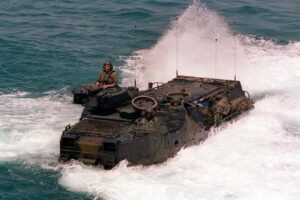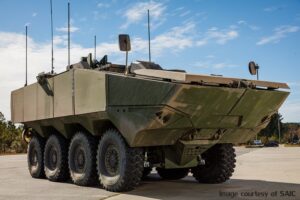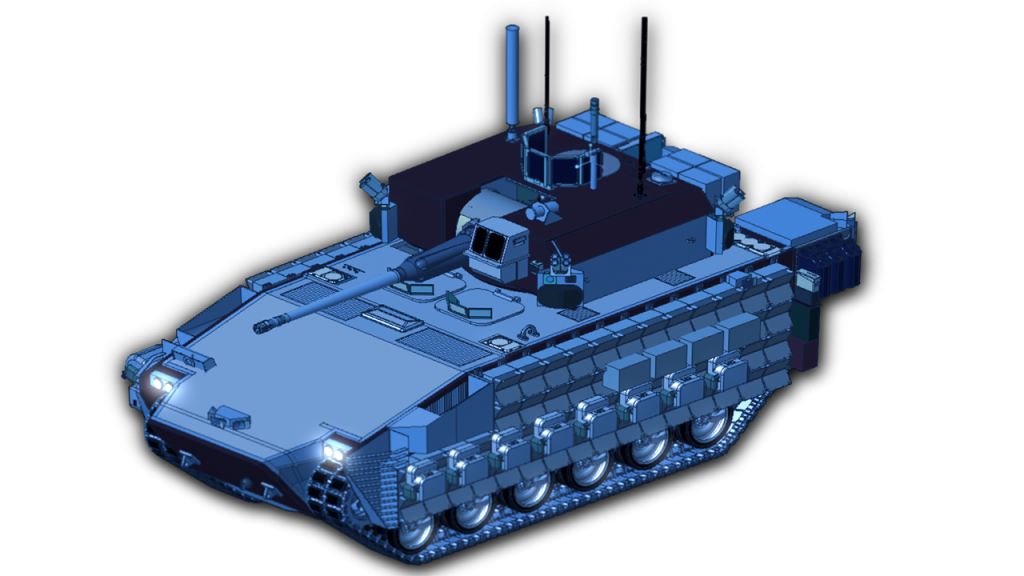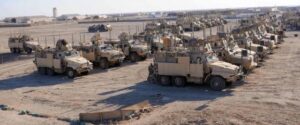SAIC’s Got No Regrets On Armored Vehicle Losses
Posted on
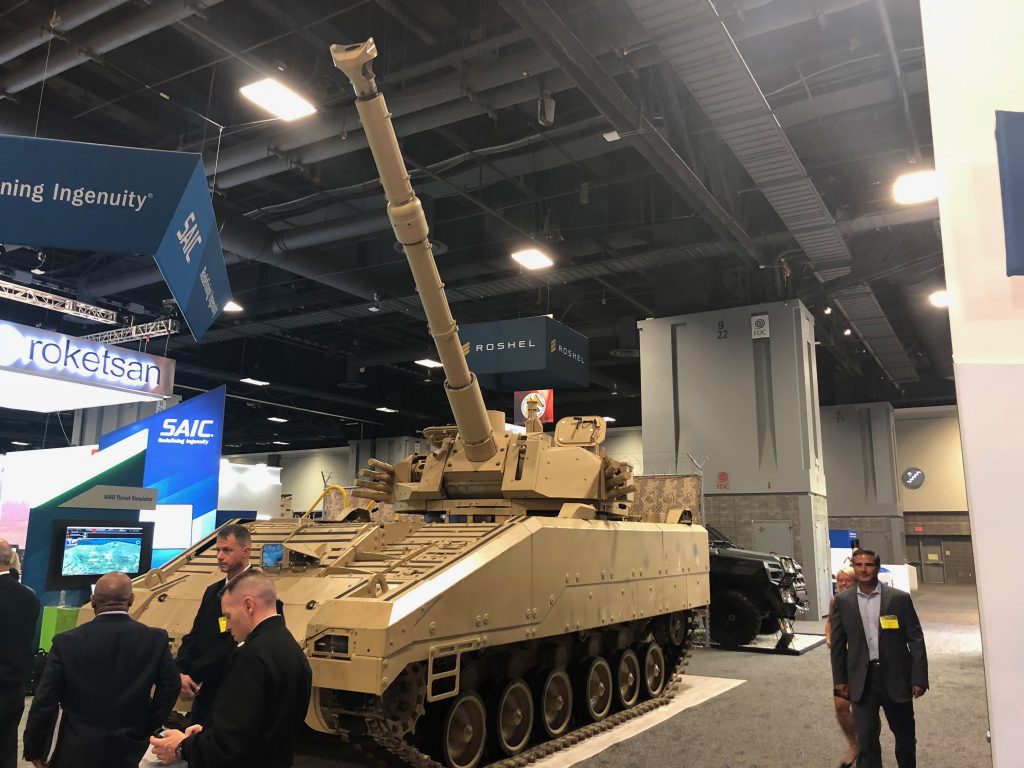
SAIC-STK offering for the Army’s Mobile Protected Firepower (MPF) light tank competition at AUSA 2018
WASHINGTON: Despite losing out on three big production contracts in the last eight months, SAIC considers its armored vehicle business “successful” because of the development work it’s done, the company’s CEO and COO told me.
SAIC is not a traditional heavy-metal manufacturer and it shouldn’t be judged like one, Tony Moraco and Nazzic Keene said in an interview Tuesday. Especially with its $2.5 billion bid to acquire Engility, SAIC is primarily an engineering and services company with an increasing focus on space, cyberspace, and intelligence. It doesn’t build vehicles in factories of its own, but installs and integrates electronics on war machines built elsewhere so it doesn’t have the massive overhead costs that only a production contract can cover, the executives argued. While a production run would be great, they said, development contracts and upgrade work are enough to keep this side of SAIC going.
“We can continue to do the upgrades and integration services that we’ve done for decades. We saw the step to a larger production [contract] as essentially upside,” said Moraco, SAIC’s CEO. “We have not broken through [to] a large production program but [have been] very successful in EMD phase” -– i.e. Engineering & Manufacturing Development.
“We have been successful over the course of the last few years,” added Keene, the COO. “[We’ve] been a disruptor in this market.”
Is Fourth Time The Charm?
What SAIC executives told me Tuesday, though, doesn’t quite match what they said a year ago when the company expanded its manufacturing facility in Charleston, South Carolina. That’s where it had installed modern electronics on thousands of MRAP trucks for the Iraq and Afghan wars. Years ago, though, the military stopped buying MRAPs and started dismantling them – but SAIC doubled down on Charleston. “The beauty of the new facility is that we’re able to design it up front to optimally handle multiple large-scale programs,” senior VP Bob Carruthers told the local paper at the time (emphasis ours).
When SAIC said that, though, they thought they had at least one big contract to keep Charleston humming: rebuilding 400 Marine Corps Amphibious Assault Vehicles (AAV), decades-old machines which had proved dangerously vulnerable to IEDs in Afghanistan and Iraq. Officially called an upgrade, the AAV survivability program was really a top-to-bottom overhaul, with SAIC providing everything from new armor, blast-proof seats, and tracks to a whole new powertrain. But the program, potentially worth up to $1.2 billion, was canceled in September after only about $125 million had been spent.
Nevertheless, Moraco told me, “the AAV survivability upgrade was … a success in upgrading a 30-year old platform.”
By all accounts, Moraco’s right to say SAIC’s engineering work on AAV was unimpeachable. The company did nothing wrong. But the Marines decided they no longer needed to invest in keeping their old AAVs battle-worthy when the replacement, the Amphibious Combat Vehicle (ACV), was coming along better and faster than expected.
SAIC had also bid on ACV, offering a variant of the Singaporean army’s Terrex. ST Kinetics would build the vehicle, SAIC would customize it for the American user. The Marine Corps was impressed enough to pay SAIC $121.5 million to build 16 prototypes for assessment. But in June, the Marines awarded the ACV production contract – for at least 200 machines, potentially 600 – to a well-established armored vehicle manufacturer, BAE Systems. (BAE offered a modified Italian design).
Moraco argues, much as he did on AAV, that SAIC deserves credit for the Engineering & Manufacturing Development (EMD) work it did on its Amphibious Combat Vehicle prototypes. “We consider ACV EMD as a successful program over a multi-year period to introduce technologies, although we didn’t win the production contract,” he told me.
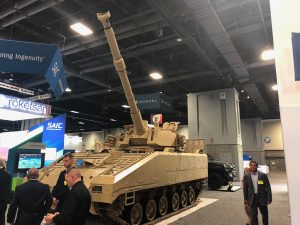
SAIC-STK offering for the Army’s Mobile Protected Firepower (MPF) light tank competition at AUSA 2018
Meanwhile, the Army was looking for a new light tank to accompany airborne troops and other infantry where the massive M1 Abrams couldn’t go. SAIC teamed up with the Singaporeans again on this Mobile Protected Firepower program, putting together a working prototype, but this time the military didn’t even give them a development contract. Instead, just last month, the Army awarded BAE and another traditional tank-builder, General Dynamics, $375 million and $335 million respectively to refine their designs and build a dozen prototypes apiece. The winner would build over 500 vehicles – potentially more if the Marines and/or foreign allies want the light tanks too.
The next big armored vehicle opportunity – far bigger than AAV, ACV, or MPF – is the Army’s Optionally Manned Fighting Vehicle, meant to replace hundreds of aging and much-upgraded M2 Bradley troop carriers. An official Request For Proposals to kick off the program is expected within weeks. The three declared contenders for OMFV so far are the usual suspects – BAE and General Dynamics – plus a team-up of Raytheon, best known for electronics and aircraft, with German tank-maker Rheinmetall.
Will SAIC offer a Bradley replacement too? Moraco and Keene declined to answer. Moraco did say “it’s one of many programs we would consider” if the business case, impact on SAIC’s investment portfolio, and the potential for a win all made sense.
But even if SAIC teams up with a traditional manufacturer of armored vehicles, as they did for the Marine ACV and Army MPF, there’ll be a significant cost to participate and no guarantee of a development contract. Going after a fourth heavy-metal contract in a row is a definite risk – but also the biggest opportunity for SAIC to establish itself as a builder of armored vehicles after three successive misses.
Playing To Their Strengths
Whether SAIC tries to build the Bradley replacement or not, however, the company already has a role in Army modernization, leading a six-company team on an eight-year, $237 million contract to develop prototype Next Generation Combat Vehicles. (NGCV originally referred to the Bradley replacement but has taken on a broader meaning to refer to a whole portfolio of manned and unmanned vehicles).
It’s an “engineering program that, again, introduces new technologies in the context of prototyping,” Moraco told me. “It’s not necessarily geared to a full up production, but it is a very critical component for the Army [to help them] test and prototype and drive that into other programs of record.”
That’s the kind of work that SAIC says plays to their strengths. The Pentagon increasingly wants high-tech innovation, not just tons of metal. SAIC has a “long history in complex systems integration,” going back even before the much-lauded MRAPs to the Army’s (canceled) Future Combat Systems, Moraco said. “We are very much still in that game, [and] we’re still very bullish… on the engineering side.”
The thing about SAIC’s kind of engineering work is that it requires a lot of brainpower – and a cadre of expensive, highly skilled personnel – but not a lot of physical infrastructure. “Our business model is a services model,” Moraco told me. “We are not an OEM [Original Equipment Manufacturer] in the form of having a factory and fixed costs that you have to carry on the front end and then recover on the back end” – i.e. in a long production run.
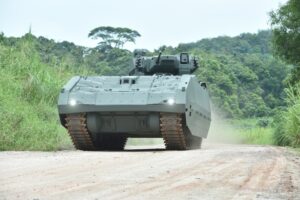
STK’s Next Generation Armored Fighting Vehicle, already in production for the Singaporean army when SAIC proposed modifying it for US use.
Instead, he said, “we use our suppliers to actually carry that infrastructure.” On ACV and MPF, for example, the Singaporeans had already built the factories and starting building the vehicle for their own army. That meant neither SAIC nor its US customers had to pay the start-up costs.
The exception that Moraco argues proves this rule is the Charleston facility. Is it viable without a major production contract? “It’s large integration facility, not a factory production line,” he insisted. “We’re doing late-stage systems integration, integration of the subsystems, rather than fabrication and manufacturing.”
Finally, ground vehicles simply aren’t a big part of what SAIC does, so the company can take hits in that sector and keep on ticking profitably.
“There’s certainly a lot of interest in this particular part of our portfolio,” said COO Keene. “It’s an important part …. it serves the warfighter … but it’s a very small part of the portfolio.”
Subscribe to our newsletter
Promotions, new products and sales. Directly to your inbox.



